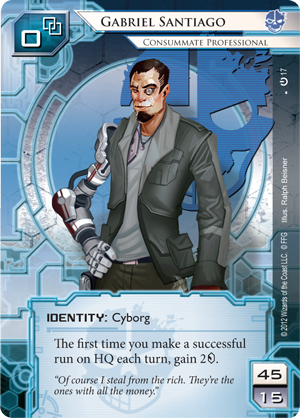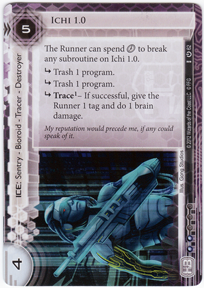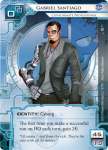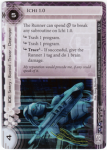Netrunner, the third CCG from Wizards of the Coast/Richard Garfield, has been relaunched recently by Fantasy Flight Games as Android: Netrunner. It's really odd to see the copyright at the bottom of each card, which attributes to both WotC and FFG. The setting for the game is taken from the Android boardgame from FFG.
If you haven't heard of the game, it's a asymmetric card game based on Cyberpunk fiction, where one player plays the corporation, trying to complete their agendas and protecting their plans with ICE (Intrusion Countermeasures Electronics), while the other player play a netrunner, trying to hack into the corporations sites and steal their agendas. The first to score seven points of agendas wins the game.
One very nice thing about the game is though you still build decks and pit them against the decks of your opponents, it is being released using FFG's Living Card Game model, which means that each set and expansion pack is completely non-random. With one expansion pack of 60 cards being released each month (3 copies each of 20 new cards), it's not all that hard to keep up with the game, although buying into the game later can be quite expensive if you want everything.
[imager]
 [/imager]The Core Set contains the pieces for seven decks: four corporations and three runners. You can only build two decks at a time, though, as there are a set of neutral cards (one for corporations and one for the runners) which you add to the themed decks to complete them. The decks are quite playable, although some are very, very challenging to run well.
[/imager]The Core Set contains the pieces for seven decks: four corporations and three runners. You can only build two decks at a time, though, as there are a set of neutral cards (one for corporations and one for the runners) which you add to the themed decks to complete them. The decks are quite playable, although some are very, very challenging to run well.
The four corporations are:
* NBN, a broadcaster. It doesn't have much in the way of ICE that stops the runner, instead trying to trace and tag the runner, which will then allow them to play merry havoc with the runner's resources.
* Jinteki has a host of ICE programs that try to flatline the runner.
* Hans Bioroid installs ICE cheaply, and tries to brain damage the runner, but the runner can get past a lot of their ICE with time.
* Weyland Consortium gets more money than any other corp, despite getting Bad Publicity for it...
The three runners are
* Noise, an anarch, who uses viruses to play with the corporation rather than using more traditional codebreakers
* Gabriel Santiago, a criminal, who has the contacts to get a lot of money from the information he steals
* Kate "Mac" McCaffrey, a shaper, who modifies programs and ICE better than anyone else to serve her needs.
The factions are a change to the original Netrunner game, which had everyone able to use any card of their side (corporation or runner). They provide more restrictions on deckbuilding, and the identity cards (a new addition) all have their own special abilities. The expansions will add more identities, so you can have different runners and corporations for the different factions. Well, different runners, although I'm not sure how they'll deal with the corporations.
It is possible when deckbuilding to include cards of different factions, but there is a limit to how many cards you can include. Each faction card has an Influence cost, and your identity limits how many Influence points you can include from other factions. A few cards (all Agendas in this set) can't be included as out-of-faction cards.
The game itself is basically the one Richard Garfield designed many, many years ago, although a few rules have been tweaked. It's a very cerebral game of bluffing and puzzle-solving. The corporation plays most of their cards face-down: assets and agendas to aid them, ice to protect their network sites, and the occasional trap in a fake server just there to lure the runner. The runner, in contrast, plays their cards face-up. The corporation can always see what they're doing. But it's the runner who controls the pace of the game for the most part, choosing when to do runs against the corporation. The corporation can rarely directly interact with the runner, instead spending most of their time advancing their agendas and installing cards to protect them.
I've played over twenty games of the new Netrunner since it was released a couple of weeks ago, and I'm greatly enjoying it. Although one core set is enough to teach you the game, it's not enough to do serious deckbuilding: you'll want two sets, which is what most of the players here have bought. (At under $100, it's still a lot cheaper than what I spend on Magic: the Gathering). The Core set, unlike the expansion packs, uses a "lumpy" distribution pattern so that it plays well out-of-the-box, and contains three of some cards and only one of others. You have a limit of three copies of the same card in your deck, so two core sets will give you six of some cards, four of others and only two of a very few cards. Thankfully, those cards are rarely ones you'd want three of, so two core sets will likely be my limit. You can download the card list and number of cards from FFG's site here.
Most of the games I've played have been against my regular opponent, Sarah, who is an excellent player of many games (wargames, boardgames, RPG and CCGs). They've been, in general, very close, with the games being won by one side only just before the other side won. This isn't always the case; particularly bad draws by the corporations can lead to their hand being flooded with agendas with no way to protect them, which can cause the runner to win very quickly. There is a mulligan rule, but games *can* end very quickly.
Corporations generally can't win that quickly; if they do it'll be because of a stupid play on the case of the runner. My most recent game was an example of that, and is the quickest win yet of a Corporation. I'll describe the game in full below, but a quick explanation is in order: during a Runner's turn, they get four actions to advance their plans. The Corporation gets three actions, plus a free (or forced) card-draw at the beginning of the turn. Standard uses for actions are to gain $1, draw a card, play a card, or make a run.
[imager]
 [/imager]NBN (Merric): Turn 1
[/imager]NBN (Merric): Turn 1
* Plays a face-down card in a new remote server.
* Plays a face-down ICE card to protect the server.
* Takes $1, to end the turn on $6 with 4 cards in hand.
Santiago (Sarah): Turn 1
* Installs the program "Magnum Opus", which will allow her to take actions to gain $2 rather than $1. It's a very good program.
* Makes a run against the remote server I'd set up.
- I 'rez' the ICE card she approaches by paying $5. It's ICHI 1.0. Sarah decides to spend her two remaining actions to stop it trashing her Magnum Opus, but takes the brain damage (a permanent reduction in hand size) and takes a tag. She does reach the site though, and steals the agenda I'd played there, and scores 2 points. (Private Security Force).
NBN (Merric): Turn 2
* Take $1
* Take $1
* Play "Scorched Earth" for $3, which I can only do because Sarah has a tag, which does 4 meat damage to her. Each damage forces her to discard a card, but she only has three cards in hand. She flatlines and loses the game.
This was a most atypical game, but it was set up by my including two out-of-factions cards in my NBN deck. Sarah expected light ICE which would perhaps tag her or stop the run, and certainly not the ICHI ice, which is a signature part of Hans-Bioroid, not NBN. If she'd allowed her Magnum Opus to be trashed, she could have survived the experience, but she didn't expect the Scorched Earth follow-up.
Part of what makes the game so compelling is the bluffing and the unexpected. The Runner gets to see how much ICE is protecting the corporation, but now what it is. Once it is exposed, then they can play icebreaker programs that will cut through it. However, this costs money, and money is something that both the Runner and the Corporation have in short supply. Both cards and money can be gained by spending actions, but you have so few actions. I've spent entire turns just gaining cards and money, and I always feel like I've just let my opponent get a huge advantage.
One unusual aspect of the release of the game is just how few cards are in the basic set: only about 113 unique cards. This compares to the 374 cards in the original Netrunner game by Wizards of the Coast! Deckbuilding is thus a lot more limited. Personally, I think there's quite a bit of diversity in the decks we've been building, but there's no doubt that we'll soon be very eager for the first of the upgrade packs. Mind you, I've played it 28 times so far, and I'm now eager to try a new deck, so the lack of cards isn't *that* bad.
Our games have taken about 20-30 minutes, depending on the speed of the players and how many resources we can draw to move the game along. One "oops" moment we've occasionally had is not returning the stolen agendas to the corporation deck, which led to one memorable game where both decks were about depleted by the time enough agendas were scored for the game to end. Apparently different card backs for the runner and corporation isn't enough to stop a player absent-mindedly shuffling cards of the opposite side into their deck!
My local store has about eight or nine players now playing Netrunner, which is pretty good in such a small city as Ballarat. The game has proved very popular, and we're still very much in the exploration phase; no 'killer' deck has reared its head. Some factions are easier to play than others, but I very much enjoy the challenge of playing less obvious factions (like NBN). It's been a big success for us so far, and I'm likely to play a lot of Netrunner in the oncoming weeks. It's been a very good release from FFG, and a worthy addition to their LCG lines.
If you haven't heard of the game, it's a asymmetric card game based on Cyberpunk fiction, where one player plays the corporation, trying to complete their agendas and protecting their plans with ICE (Intrusion Countermeasures Electronics), while the other player play a netrunner, trying to hack into the corporations sites and steal their agendas. The first to score seven points of agendas wins the game.
One very nice thing about the game is though you still build decks and pit them against the decks of your opponents, it is being released using FFG's Living Card Game model, which means that each set and expansion pack is completely non-random. With one expansion pack of 60 cards being released each month (3 copies each of 20 new cards), it's not all that hard to keep up with the game, although buying into the game later can be quite expensive if you want everything.
[imager]
The four corporations are:
* NBN, a broadcaster. It doesn't have much in the way of ICE that stops the runner, instead trying to trace and tag the runner, which will then allow them to play merry havoc with the runner's resources.
* Jinteki has a host of ICE programs that try to flatline the runner.
* Hans Bioroid installs ICE cheaply, and tries to brain damage the runner, but the runner can get past a lot of their ICE with time.
* Weyland Consortium gets more money than any other corp, despite getting Bad Publicity for it...
The three runners are
* Noise, an anarch, who uses viruses to play with the corporation rather than using more traditional codebreakers
* Gabriel Santiago, a criminal, who has the contacts to get a lot of money from the information he steals
* Kate "Mac" McCaffrey, a shaper, who modifies programs and ICE better than anyone else to serve her needs.
The factions are a change to the original Netrunner game, which had everyone able to use any card of their side (corporation or runner). They provide more restrictions on deckbuilding, and the identity cards (a new addition) all have their own special abilities. The expansions will add more identities, so you can have different runners and corporations for the different factions. Well, different runners, although I'm not sure how they'll deal with the corporations.
It is possible when deckbuilding to include cards of different factions, but there is a limit to how many cards you can include. Each faction card has an Influence cost, and your identity limits how many Influence points you can include from other factions. A few cards (all Agendas in this set) can't be included as out-of-faction cards.
The game itself is basically the one Richard Garfield designed many, many years ago, although a few rules have been tweaked. It's a very cerebral game of bluffing and puzzle-solving. The corporation plays most of their cards face-down: assets and agendas to aid them, ice to protect their network sites, and the occasional trap in a fake server just there to lure the runner. The runner, in contrast, plays their cards face-up. The corporation can always see what they're doing. But it's the runner who controls the pace of the game for the most part, choosing when to do runs against the corporation. The corporation can rarely directly interact with the runner, instead spending most of their time advancing their agendas and installing cards to protect them.
I've played over twenty games of the new Netrunner since it was released a couple of weeks ago, and I'm greatly enjoying it. Although one core set is enough to teach you the game, it's not enough to do serious deckbuilding: you'll want two sets, which is what most of the players here have bought. (At under $100, it's still a lot cheaper than what I spend on Magic: the Gathering). The Core set, unlike the expansion packs, uses a "lumpy" distribution pattern so that it plays well out-of-the-box, and contains three of some cards and only one of others. You have a limit of three copies of the same card in your deck, so two core sets will give you six of some cards, four of others and only two of a very few cards. Thankfully, those cards are rarely ones you'd want three of, so two core sets will likely be my limit. You can download the card list and number of cards from FFG's site here.
Most of the games I've played have been against my regular opponent, Sarah, who is an excellent player of many games (wargames, boardgames, RPG and CCGs). They've been, in general, very close, with the games being won by one side only just before the other side won. This isn't always the case; particularly bad draws by the corporations can lead to their hand being flooded with agendas with no way to protect them, which can cause the runner to win very quickly. There is a mulligan rule, but games *can* end very quickly.
Corporations generally can't win that quickly; if they do it'll be because of a stupid play on the case of the runner. My most recent game was an example of that, and is the quickest win yet of a Corporation. I'll describe the game in full below, but a quick explanation is in order: during a Runner's turn, they get four actions to advance their plans. The Corporation gets three actions, plus a free (or forced) card-draw at the beginning of the turn. Standard uses for actions are to gain $1, draw a card, play a card, or make a run.
[imager]
* Plays a face-down card in a new remote server.
* Plays a face-down ICE card to protect the server.
* Takes $1, to end the turn on $6 with 4 cards in hand.
Santiago (Sarah): Turn 1
* Installs the program "Magnum Opus", which will allow her to take actions to gain $2 rather than $1. It's a very good program.
* Makes a run against the remote server I'd set up.
- I 'rez' the ICE card she approaches by paying $5. It's ICHI 1.0. Sarah decides to spend her two remaining actions to stop it trashing her Magnum Opus, but takes the brain damage (a permanent reduction in hand size) and takes a tag. She does reach the site though, and steals the agenda I'd played there, and scores 2 points. (Private Security Force).
NBN (Merric): Turn 2
* Take $1
* Take $1
* Play "Scorched Earth" for $3, which I can only do because Sarah has a tag, which does 4 meat damage to her. Each damage forces her to discard a card, but she only has three cards in hand. She flatlines and loses the game.
This was a most atypical game, but it was set up by my including two out-of-factions cards in my NBN deck. Sarah expected light ICE which would perhaps tag her or stop the run, and certainly not the ICHI ice, which is a signature part of Hans-Bioroid, not NBN. If she'd allowed her Magnum Opus to be trashed, she could have survived the experience, but she didn't expect the Scorched Earth follow-up.
Part of what makes the game so compelling is the bluffing and the unexpected. The Runner gets to see how much ICE is protecting the corporation, but now what it is. Once it is exposed, then they can play icebreaker programs that will cut through it. However, this costs money, and money is something that both the Runner and the Corporation have in short supply. Both cards and money can be gained by spending actions, but you have so few actions. I've spent entire turns just gaining cards and money, and I always feel like I've just let my opponent get a huge advantage.
One unusual aspect of the release of the game is just how few cards are in the basic set: only about 113 unique cards. This compares to the 374 cards in the original Netrunner game by Wizards of the Coast! Deckbuilding is thus a lot more limited. Personally, I think there's quite a bit of diversity in the decks we've been building, but there's no doubt that we'll soon be very eager for the first of the upgrade packs. Mind you, I've played it 28 times so far, and I'm now eager to try a new deck, so the lack of cards isn't *that* bad.
Our games have taken about 20-30 minutes, depending on the speed of the players and how many resources we can draw to move the game along. One "oops" moment we've occasionally had is not returning the stolen agendas to the corporation deck, which led to one memorable game where both decks were about depleted by the time enough agendas were scored for the game to end. Apparently different card backs for the runner and corporation isn't enough to stop a player absent-mindedly shuffling cards of the opposite side into their deck!
My local store has about eight or nine players now playing Netrunner, which is pretty good in such a small city as Ballarat. The game has proved very popular, and we're still very much in the exploration phase; no 'killer' deck has reared its head. Some factions are easier to play than others, but I very much enjoy the challenge of playing less obvious factions (like NBN). It's been a big success for us so far, and I'm likely to play a lot of Netrunner in the oncoming weeks. It's been a very good release from FFG, and a worthy addition to their LCG lines.












